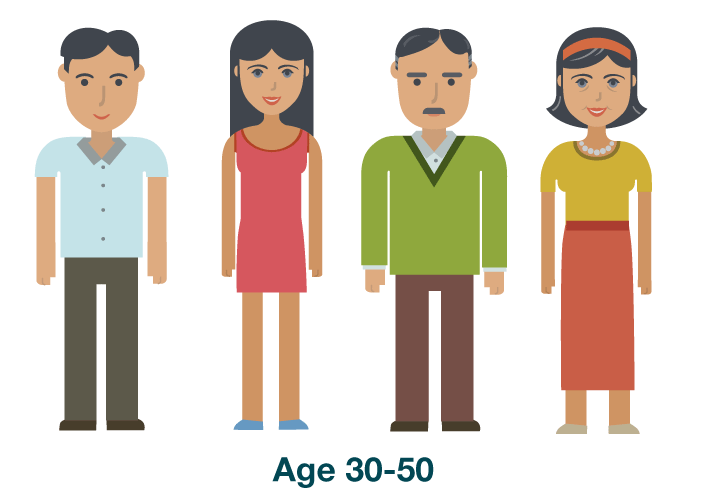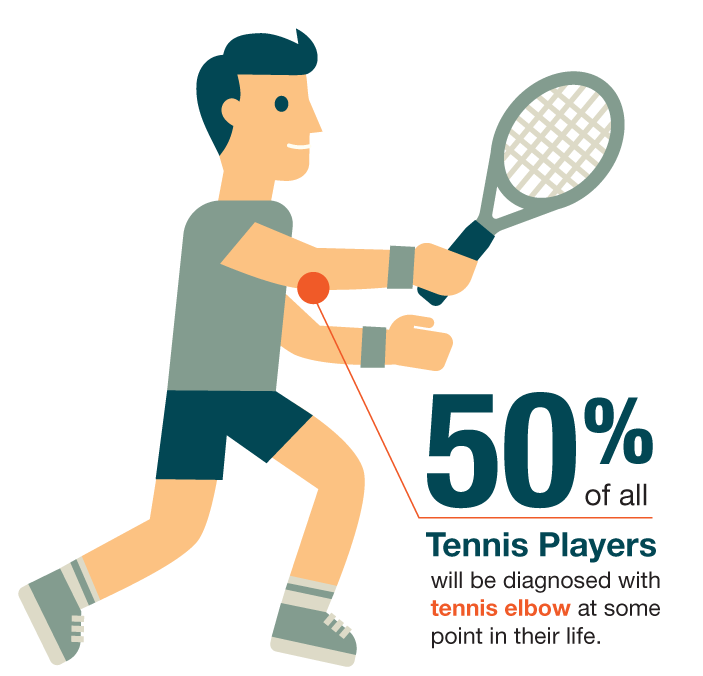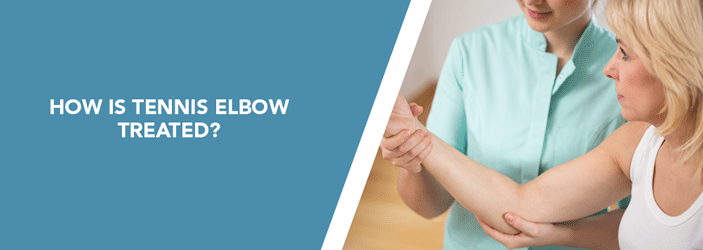-Causes of Tennis Elbow
-Treatment of Tennis Elbow
-Tennis vs Golf Elbow
If you’re experiencing regular pain when engaging in activities involving your forearm muscles, tennis elbow may be to blame. However, many patients confuse tennis elbow and golfer’s elbow. Here we will discuss different aspects of tennis elbow that will help you figure out if you may have this painful disorder. We’ll also highlight some of the differences between tennis and golfer’s elbow.
Tennis elbow can be quite uncomfortable, but the vast majority of patients will regain full strength and range of motion with proper treatment.
What Is Tennis Elbow?
Tennis elbow, also known as lateral epicondylitis, is a common overuse injury resulting from repetitive motion involving the tendons in your elbow. These tendons, the extensor carpi radialis brevis and extensor digitorum communis of the forearm, extend and stabilize the wrist as they anchor your muscles to your bones. When the attachment site weakens, you start to experience pain and tenderness while engaged in everyday activities involving gripping, grasping or lifting.
The first documented reference to tennis elbow was published in 1883, noting that frequent tennis players presented with pain in and around the elbow area of their racquet arm. Subsequent studies observed that using inappropriately matched equipment for one’s body size and muscle strength, gripping the racket too hard, hitting the ball off center and using poor technique on ground strokes increased the likelihood of tennis elbow pain.
What Are the Signs of Tennis Elbow?
Tennis elbow usually develops gradually, starting off as mild discomfort and worsening as time passes. In most cases, there is no specific incident that can be linked to the start of the symptoms.
Many people suffering from tennis elbow experience recurring pain radiating from the elbow all the way down the forearm, with pain that increases when they attempt to extend or straighten the elbow. Other common signs of tennis elbow include:
- Difficulty grasping or lifting objects
- Weak grip strength
- Sharp twinges when engaged in activities using the elbow
- Pain during and after activities involving the wrist
- Numbness or tingling in the fingers
- A dull ache when resting
Tennis elbow most often affects your dominant arm, meaning that right-handed people are more likely to develop tennis elbow in their right elbow and left-handed people are more likely to develop tennis elbow in their left elbow. However, it is possible for people to develop the condition in both arms. It is estimated that up to 20 percent of patients have some degree of bilateral tennis elbow.
Tennis elbow is usually considered degenerative rather than acute. If left untreated, tennis elbow can progress to the point where you have difficulty with simple everyday activities such as turning a doorknob, shaking hands, brushing your teeth or holding a coffee cup.
What Causes Tennis Elbow Pain?

Tennis elbow is most common in people ages 30 to 50, although the condition can be seen in people of all ages. Depending upon their activity level, children and senior citizens can be diagnosed with tennis elbow as well. There is no gender-related component to tennis elbow, and men and women are equally likely to be diagnosed with the condition.
Overuse is the most common cause of tennis elbow pain. When you frequently engage in activities that place stress on the tendon attachments and the muscle-tendon unit, microscopic tears form in the tendon where it is attached to the bone. These tears lead to the inflammation and pain associated with tennis elbow. Typically, overuse is defined as a high activity level three or more times per week with activity lasting 30 minutes or more per session. A poor overall fitness level can exacerbate the problems caused by overuse of the forearm and elbow area.
Tennis elbow pain can sometimes be linked to specific injuries or traumas. If you suffer a direct blow to the elbow, this could result in the swelling of the tendon and subsequent degeneration. When seeking treatment for your condition, it is important to inform your doctor of any injury or trauma that could be linked to the development of tennis elbow.
Finally, as with many medical conditions, genetics play a role in the development of tennis elbow. Some people are born with tendons that are naturally less durable, which makes them prone to developing the condition at an earlier age or in conjunction with pain in the shoulders and feet.
How Do You Get Tennis Elbow Without Playing Tennis?

The Nirschl Orthopaedic Center reports that half of all tennis players will be diagnosed with tennis elbow at some point in their lives. However, people who play tennis make up less than 5 percent of all reported cases of the condition. This means the majority of people diagnosed with tennis elbow can attribute their condition to other causes.
Can you get tennis elbow from baseball and other sports, then? The answer is yes. Baseball pitchers are commonly affected by tennis elbow, especially if they haven’t been properly trained as to the correct pitching mechanics, frequently pitch curve balls or have a training schedule that is too vigorous. Younger players with elbows that are still developing are particularly prone to tennis elbow.
Other sports that have been linked to tennis elbow include football, javelin, discus, badminton and squash. The more frequently a person plays one of these sports, the more likely they are to develop the condition.
If you don’t play sports at all, you can still get tennis elbow from any sort of regular manual labor that involves lifting of the wrist and/or repetitive turning motions. This includes plumbing, meat cutting, painting and bricklaying, as well as typing. Hairdressers are also vulnerable to tennis elbow due to their frequent use of scissors, shears and other styling tools.
If you enjoy arts and crafts in your spare time, you may be vulnerable to tennis elbow due to the fine, repetitive hand and wrist movements involved in completing projects. For example, knitters and crocheters who work on projects for several hours at a time are prone to developing elbow pain. Scrapbooking can also be problematic due to the detailed cutting that is often involved.
How Is Tennis Elbow Diagnosed?
If you suspect that you may be suffering from tennis elbow, medical treatment is needed. Self-diagnosis can be dangerous, as tennis elbow is easily mistaken for other conditions. According to the American College of Sports Medicine, there are at least 43 different documented pathologies of the elbow joint. Many of these conditions, such as bursitis and arthritis, have symptoms that are similar to those of tennis elbow.
Tennis elbow is diagnosed based on a description of how your symptoms developed and what type of activities you engage in during a particular day. Your doctor will also consider factors such as whether you’ve previously injured your elbow and whether you have a history of nerve disease or rheumatoid arthritis.
During the initial examination, your doctor may ask you to perform basic tasks such as extending your arm fully straight and trying to straighten your wrists and fingers against resistance. If these tests are inconclusive, your doctor may order X-rays, an MRI scan or an EMG before making a final diagnosis. Bone scans may be done in rare cases to look for stress fractures or disease conditions that could be causing the elbow pain.
To assist your physician in obtaining an accurate diagnosis, it’s helpful to bring the following to your initial appointment:
- A written list of your symptoms
- Any questions you might have
- A list of any medications you are taking, including both prescription drugs and over-the-counter medicines
- A list of any previous surgeries you’ve had, as well as any injuries or other medical conditions that may be relevant to the pain you are experiencing
How Is Tennis Elbow Treated?
 Ice and anti-inflammatory, over-the-counter pain relievers such as aspirin or ibuprofen can provide temporary relief for your elbow pain. You will also want to rest the affected area as much as possible by stopping activities that irritate the tendon or by changing your technique to reduce stress on the forearm muscles.
Ice and anti-inflammatory, over-the-counter pain relievers such as aspirin or ibuprofen can provide temporary relief for your elbow pain. You will also want to rest the affected area as much as possible by stopping activities that irritate the tendon or by changing your technique to reduce stress on the forearm muscles.
Unfortunately, basic self-care at home will not resolve your tennis elbow pain permanently. The body requires new blood vessels and collagen proteins to heal the affected tendon.
Treatments for tennis elbow depend upon the severity of your pain, but may include:
- Cortisone Injections: Cortisone is used to control inflammation and relieve tennis elbow symptoms. They cannot be used long term, however. Too much cortisone can weaken sensitive tissues over time. Injections are given around the tendons and over the most painful point of the elbow, but are not directly injected into the tendon tissue itself.
- Bracing: When tennis elbow is linked to your occupation, it can be difficult to avoid activities that cause pain. In this case, functional bracing can be used to disperse forces that would normally be absorbed at the point of injury. Braces apply pressure on the muscles below the elbow to allow you to complete your daily activates with less discomfort. Tennis elbow braces are also called counterforce braces, and most commonly come in full elbow sleeve or simple strap styles that can be adjusted to provide the necessary tension around the forearm area. The braces can be worn throughout the day but should be removed before going to sleep at night.
- Physical Therapy: An experienced physical therapist can develop a personalized exercise program designed to strengthen the forearm, wrist and shoulder muscles while bringing in a new blood supply. The therapist may use massage, ultrasound and other muscle-stimulating techniques to promote healing. You might also be referred to an ergonomic specialist and/or occupational therapist if your condition is related to work activities.
- Surgery: According to the American Academy of Orthopaedic Surgeons, 80 to 85 percent of tennis elbow cases will improve after six months to one year of nonsurgical treatment. However, some patients may require surgery to remove the pain-producing tendon. After surgery, the arm is temporarily immobilized using a splint. The patient begins gradual strengthening exercises three to four weeks after the procedure, with the goal of being able to return to light athletic activity within four to six weeks and competitive athletic activity within four to six months.
Preventing Tennis Elbow Pain
Although tennis elbow treatment is very effective at relieving pain and improving range of motion, it’s possible for the condition to reoccur if the patient slips back into old habits. Modifying your daily routine is a key component of staying injury free.
If your tennis elbow is caused by work-related duties, it’s recommended that you speak to your supervisor or a company human resources representative about making accommodations to avoid a relapse. For example, if typing is the primary cause of your injury, you may need to type on a split keyboard to help your hands stay in a more natural line and use a wrist pad to keep your hands level with the keyboard at all times. You might also need to take more frequent breaks to allow for stretching and a change of positions.
If your pain is related to tennis or another sport, individualized coaching can help you refine your technique to prevent injury. In addition, a coach can check that your equipment properly fits your needs. For example, switching to a looser-strung tennis racquet reduces the stress on your forearm and keeps you from overworking your injured muscles and tendons.
Regardless of whether your tennis elbow is linked to work or recreational activities, you should make it a priority to follow through with the approved course of physical therapy. Strengthening your arm, shoulder and upper back muscles will help prevent future problems by taking stress off your elbow. Regular use of the exercises recommended by your therapist will allow you to maintain an active lifestyle without worrying about aggravating your injury.
TENNIS ELBOW VS. GOLFER’S ELBOW
You may have heard of both tennis elbow and golfer’s elbow before, but you probably don’t know what sets them apart. There’s a reason many patients confuse tennis elbow and golfer’s elbow. They share quite a few characteristics:
- Both are overuse injuries, caused by repetitive motions involving your arm and wrist.
- They both are characterized by damage to the tendons that attach your forearm muscles to the bone at your elbow.
- They both cause inflammation of the tendons but can progress to partial or full thickness tears of the tendon.
- Both cause pain to the elbow region.
- You don’t need to participate in the sport for which they’re named to get these conditions.
- Both start gradually but can get worse over time.
- Treatment for both is similar, beginning with giving your elbow and wrist a rest to reduce the amount of strain.
Despite these similarities, they are not the same conditions. In fact, they are quite distinct. Determining the correct cause for your elbow pain is the best method for receiving proper treatment. That’s why it’s important to visit your doctor who can assess your elbow and give you an accurate diagnosis.
WHAT IS GOLFER’S ELBOW?
Golfer’s elbow is a completely different disorder than tennis elbow. Medial epicondylitis, more commonly referred to as golfer’s elbow, is discomfort or irritation occurring on the inner side of the arm and elbow that is caused by activities that require repeated flexing or twisting of the wrist — for example, anything that requires you to bend your wrist downward or overuse your forearm muscles. When you do activities that require repeated lifting, especially if your elbow is extended and your palm is facing down, this can also cause the condition.
Despite the name, golfer’s elbow isn’t just limited to people who play golf. Repetitive tasks like gardening, shoveling, throwing a ball, painting and similar activities all put you at risk for golfer’s elbow. It can also be seen in weight trainers with poor technique, as well as those who work in an assembly line repeatedly bending and straightening the elbow. It is most common in people over age 40, smokers, those who are obese and those who perform repetitive activities for two or more hours per day.
People who are suffering from golfer’s elbow often experience pain when making a fist or twisting the forearm. In many cases, the affected area is tender to the touch or slightly swollen. If you are suffering from golfer’s elbow, pain often seems to worsen when you attempt to flex your wrist, pick up something with your palm down or squeeze a ball.
If the condition is not treated promptly, golfer’s elbow can cause weakness in the hands or wrist as well as stiffness in the elbow. The treatments for golfer’s elbow and tennis elbow are similar in most cases. One option is using a brace, but the best elbow brace for golfers elbow can depend on your symptoms and preferences. You will still need to seek medical care to learn the best way to handle your condition.
DIFFERENCES BETWEEN GOLFER’S AND TENNIS ELBOW
There is widespread confusion about how golfer’s and tennis elbow differ. And although they’re often confused, there are a few distinct characteristics of each condition that will help you tell them apart:
- Inflammation Location: The difference between golfer’s and tennis elbow centers on where the elbow is inflamed. A person suffering from tennis elbow will experience inflammation of the outside of the elbow and forearm areas, while a person suffering from golfer’s elbow will experience inflammation on the inner side of the arm and elbow.
- Tendon Affected: Tennis elbow affects the lateral (outside) epicondyle tendon. These are connected to the muscles that stretch your wrist backward and allow you to spread your fingers. Golfer’s elbow affects the medial (inside) epicondyle tendon. This is attached to the muscles you use to flex your wrist and contract your fingers, like when you grip something. This could present itself through inner elbow pain when you’re gripping or lifting something with your hand.
- Symptoms: The side effects of these conditions can be very similar, but they are on opposite sides of the elbow and arm. Tennis elbow presents with pain and tenderness experienced on the outside of your elbow, while golfer’s elbow can be felt on the inside of your elbow and down your arm. Golfer’s elbow can also cause numbness or tingling in your fingers.
GET HELP FOR YOUR TENNIS ELBOW PAIN
The goal of tennis elbow treatment is to help the patient regain total arm strength and endurance. Seeking medical care as soon as possible is the best way to get back to your daily routine. The medical experts at OIP will be able to diagnose your condition accurately, so you know definitively whether you have tennis elbow or golfer’s elbow.
Schedule an orthopedic appointment at OIP by using our online form or by calling 717-761-5530.


